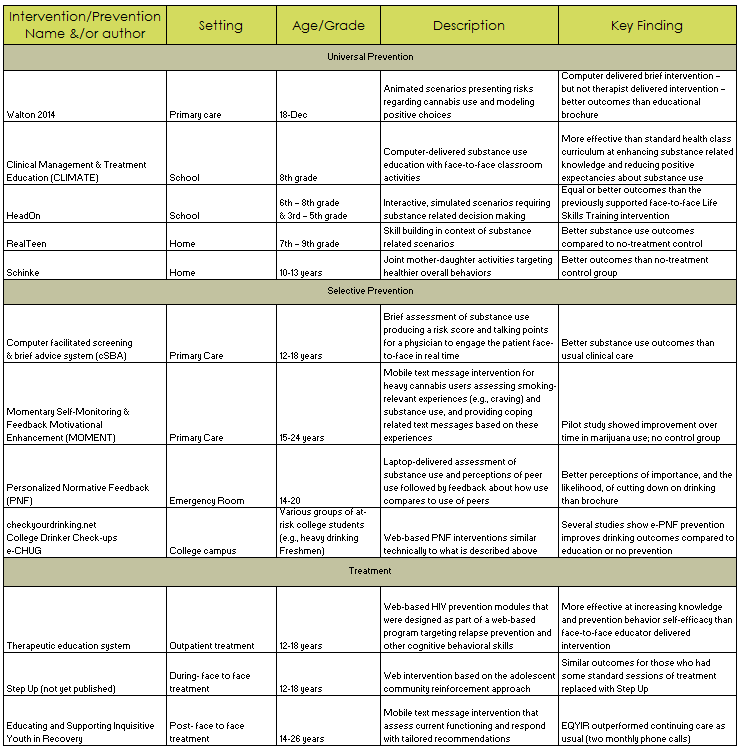Technology to Address Youth Substance Use: What’s The State-of-the-Art?
This study outlined several state-of-the-art approaches that make use of computer, online, and mobile technologies to prevent and treat youth substance use.
Alcohol use is the leading risk factor for negative health outcomes among adolescents and young adults. Given how immersed they are in digital technologies, these platforms may provide innovative ways to protect young people from the consequences of substance use, or to help them once it has already become a problem.
WHAT PROBLEM DOES THIS STUDY ADDRESS?
Alcohol use is the leading risk factor for death and disability among youth ages 15-24 across the globe, and other drug use is the second leading risk factor for disability among youth ages 20-24 . The substantial negative effects of substance use on health outcomes is due to both the risks inherent in any type of use as well as the more prolonged pattern of consequences characterized in substance use disorders. It is important to identify effective strategies to address all different levels of risk related to substance use.
Technology-based resources – i.e., delivered in an electronic, mobile, or online format – may be critical tools toward both of these goals. Here we summarize a review by Marsch and Borodovsky of the most up-to-date evidence on technology-based resources to address young people’s substance use.
HOW WAS THIS STUDY CONDUCTED?
In this study, authors used their expertise in the field of technology-based resources for substance use among adolescents and young adults to review the current evidence.
WHAT DID THIS STUDY FIND?
The table below provides an extensive overview of the interventions reviewed.
They are organized according to the following categories consistent with the authors’ designations, which were based on guidelines from the Institute of Medicine :
- Universal prevention
- Selective prevention (for at-risk youth)
- Treatment

WHY IS THIS STUDY IMPORTANT
This study outlined several empirically-supported interventions that use technology to improve youth substance use. These tools could serve many purposes including reducing clinician burden, as well as providing innovative ways to engage young people that might not otherwise be possible both in terms of their attractiveness and their accessibility.
An important observation is that these resources make use of well supported theories about how people change their drinking and other drug use, and adapt existing empirically-supported face-to-face approaches. In other words, their development and evaluation were guided by science.
- LIMITATIONS
-
- One limitation is that this was a narrative review based on articles selected by the authors focused on effective treatments. The review did not capture all research on technology-based approaches for youth substance use. For example, a recent study showed that a smartphone application for adolescents in treatment that assessed them over time and facilitated involvement in recovery-related activities may be a promising continuing care intervention after residential treatment (see here for a summary of this study in prior RRI Bulletin issue). Although not a meta-analysis (a quantitative/statistical analysis summary of many studies and analyses) nor a systematic review (where all articles meeting certain inclusion criteria are including in the review), it highlights the scope of helpful technology-based resources.
- NEXT STEPS
-
As the study authors of the study noted, social media provides a relatively new set of innovative platforms to engage youth and develop and test substance related interventions, warranting further study. A study conducted with Australian college students that were drinking at “hazardous” levels (based on the alcohol use disorder identification test), for example, showed that personalized normative feedback delivered through Facebook enhanced drinking outcomes compared to a no-treatment control .
BOTTOM LINE
- For Individuals & families seeking recovery: There are several technology-based programs for substance use prevention (i.e., before starting to use substances or before substance use has become a life-impacting problem) as well as treatment (once it has become a life impacting problem) that are likely to be helpful. Currently very few of these empirically-supported technology-based resources for youth can be accessed outside of professional settings, though there are exceptions (e.g., checkyourdrinking.net). If you are in a professional setting, it is important to ask if the approach they are suggesting is supported by research – the table here might be helpful a helpful guide for that.
- For scientists: This narrative review provided critical information about empirically-supported substance use prevention and intervention resources that leverage technology. Given that it focused on just those approaches shown to be helpful by design, a meta-analysis focusing on the effectiveness of one particular area (e.g., universal prevention or treatment) may be helpful to contextualize the overall effect size of these approaches relative to other empirically-supported treatments for youth.
- For policy makers: This review article provides a detailed overview of some of the most effective technology-based resources for youth substance use prevention and treatment. If you are considering a policy to address youth substance use, either before it starts, when it begins to appear risky, or once it has become a problem, the technology-based approaches reviewed here (see table above) are either promising or empirically-supported, and thus may be a good starting place.
- For treatment professionals and treatment systems: This review article provides a detailed overview of some of the most effective technology-based resources for youth substance use prevention and treatment. If you are problem solving ways to better engage and treat young people, the technology-based approaches reviewed here (see table above) are either promising or empirically-supported, and thus may be a good starting place.
CITATIONS
Marsch, L. A., & Borodovsky, J. T. (2016). Technology-based Interventions for Preventing and Treating Substance Use Among Youth. Child and Adolescent Psychiatric Clinics of North America, 25(4), 755-768.

